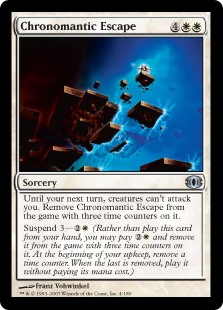Magic is a game of percentages. Like any system that leverages math, probability, and statistics to gauge your best course of action, beneath the exquisite artwork and involved storyline lies a game with an extensive latticework of number-crunching that will factor into the outcome of a playthrough just as much as any of your tactical decisions. In fact, whether you realize it or not, those calculated choices throughout each and every game are based on those statistical percentages. All of which makes sense: the more complex a game becomes the more likely such infrastructure is needed. Plus, Magic’s creator, Richard Garfield, has a doctorate in mathematics.
Determining the likelihood that your opponent will have an appropriate answer when you attack. Deciding the least dangerous moments for letting your guard down to advance your board state. Trying to ascertain the odds of drawing specific cards (such as land) you may need at any given moment. Figuring out the best timing for when to take a gamble – or when not to. And of course, the ultimate percentage marker: bringing someone’s life total from 100% to 0%. While Magic is chock full of under-the-hood style management that becomes second nature after an initial adjustment period, so much so that most don’t even notice all of the mathematical tabulations being processed at every moment of every game, it is an ever-present force that dictates the vast majority of the every game outcome.
Granted, trying to see this all at work becomes increasingly difficult and less reliable in a format such as Commander, but that’s also part of why so many longstanding Magic players enjoy the format. There’s an appeal to not feeling like the outcome is purely numbers-driven.
Well, okay, it still is. It’s just that the math gets exponentially more difficult to try to factor in your head.
Percentages also play a big factor in this article series in terms of the amount of time and effort poured into each article, with some taking up a much larger percentage of my focus and attention than others. Although I regret none of this, and consider it time well-spent, it nevertheless is something I am mindful of. I always aim to stick to my goal of letting these Monday segments remain short and sweet. Pointed, reflective, informative, yes, but also brisk.
Sometimes, a topic or mindset creates a much longer piece than originally intended, such as last week’s, wherein its length was 200% that of what I typically aim these pieces to be on average. However, to compensate and keep my monthly time investment on par, I’m keeping this week’s segment on the shorter end.
Luckily, as it would happen this week’s card too deals with percentages. Specifically, the percentage of the time you’re allowed to be attacked.
Today we have: Chronomantic Escape

Name: Chronomantic Escape
Edition: Future Sight
Rarity: Uncommon
Focus: Damage Prevention
Highlights: The Time Spiral block saw a host of unique and strange mashups of card mechanics and abilities, to say nothing of the extensive homages and callbacks from the flavor side. However, in still needing to be a cohesive Magic block design-wise, we also saw the typical evolution of what you can do with a block’s principal mechanic – in this case, Suspend.
In Time Spiral, Suspend offered the means of delay-casting a spell for several turns by paying an alternative cost. Planar Chaos modified that template by offering up a popular five card spell cycle by which you could only cast them via Suspend. With Future Sight came another iteration, of which Chronomantic Escape is part, by which the card when successfully resolved re-Suspends itself to be cast again three turns later.
Essentially, you only have to pay to cast it once, and so long as the spell doesn’t get countered, it will recast itself over and over. Which is a pretty appealing idea in general, let alone in Commander where card slots and the ability to sustain yourself over the span of several hours is of paramount concern when choosing what to include in your deck.
In the case of Chronomantic, for six mana as a hard cast (or a mere three mana if you want to jump right into Suspend mode), this spell states that upon resolution, you are not able to be attacked until your next turn. By anyone. Regardless of the number of players. In EDH, this is a substantial means of protecting yourself for next to zero investment.
Some may wonder about the usefulness of a card that only shields you from combat 33% of the time, but that’s still a huge reduction in the number of rounds you have to prepare yourself against attacks by an opponent. This actually opens up a plethora of potential to either shore up your defenses or make more assertive moves without worry about immediate combat-based reprisal. It also allows you to funnel your defensive options into the subsequent rounds, increasing the odds you are properly prepared for your enemies the other 66% of the time.
Is it complete defensive immunity? No. But every little bit helps when staring down multiple armies. This unassuming sorcery provides a semi-permanent combat shield for 1 out of every 3 turns – for as little as three mana.
Yeah. That’s a percentage easily worth praising.
Keep an eye out for us to be regularly featuring other more accessible-but-worth-it Commander cards going forward. In the meantime, we’ll keep the light on for you.
![]()
You can discuss this article over on our social media!
